In a vast and rich region of America, the Maya people created one of the most original and grandiose ancient civilizations. The ancient Mayas did not constitute a homogeneous group, but rather a collection of ethnicities with distinct languages, customs and historic realities, but who share features which allow us to integrate them in a cultural unity. At the same time, this unity, along with other ancient civilizations of Mexico, formed a part of another greater one, the Mesoamerican culture.
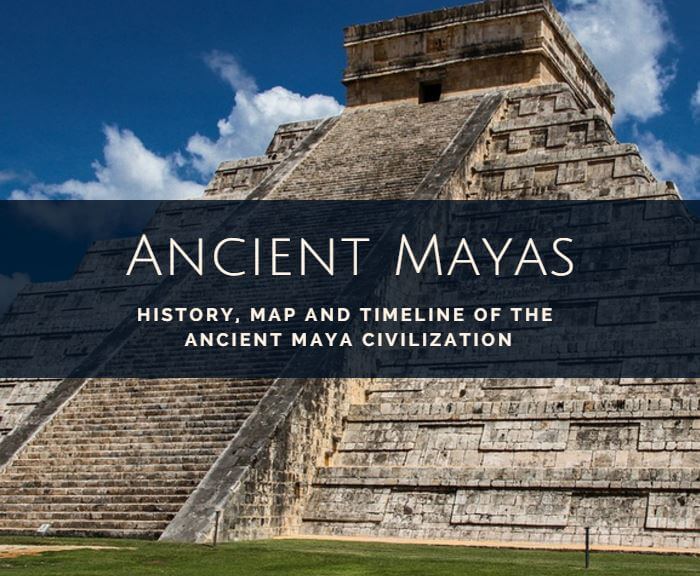
Ancient Maya Civilization
Contents
Introduction
In this post, we will observe the three great periods of the course of Maya history, which are: Preclassic, Classic, and Postclassic.
There has also been much discussion on the “disappearance” of the Mayas, but this is an error, as what disappeared was their liberty and the great culture they created in the Pre-Hispanic era; but the Maya men with their daily customs and a good part of all their beliefs still remain in their original regions, sustained in their same ancestral conception of the world and of life.
Geographic location
The ancient Maya culture covered the southeast territory of what is today the Mexican republic and which corresponds to the states of Yucatan, Campeche, Tabasco, Quintana Roo, and the eastern portion of Chiapas, as well as the greater part of Guatemala, Honduras, El Salvador, and Belize, covering a territorial extension which varies, according to the various archaeologists and historians, between 325,000 and 400,000 Km2, having as its limits the Gulf of Mexica and the Caribbean Sea; the Pacific Ocean; the Grijalva River (known in Guatemala as the Usumacinta River) in the state of Tabasco, the Ulúa River, and the Lempa River, in what is now Honduras and El Salvador, respectively.

They were divided, for the purposes of this study, in three large regions or natural zones:
1st- Northern Zone
Which includes the current states of Yucatan, in its totality and the greater part of Campeche and Quintana Roo. In such territory, the terrain is stony and semiarid with lower areas where a vast calcareous plain with the vegetation of low hills predominates, with a climate which is regularly dry and excessively warm. There are no rivers on the surface, but the terrain is permeable and water filters through it rapidly, forming subterranean currents which open in natural mouths called “cenotes.”
2nd – Central Zone:
Includes from the Usumacinta or Grijalva River in the current state of Tabasco, to the eastern part of Honduras, also including the Guatemalan Department of Petén, Belize, and part of Chiapas. It has a hot and humid climate, with abundant rains during their season. The vegetation is of the tropical type.
3rd – Southern Zone:
It encompasses the highlands and the coastal strip of the Pacific Ocean, with part of Chiapas, Guatemala, and El Salvador. The climate is temperate and cold in the mountains, with hot and humid zones, populated densely for the most part with pine groves and cypresses. There are elevations which surpass 1500 meters above sea level.
History of the Mayas
The historical trajectory of the Pre-Hispanic Maya civilization has been divided into three periods:
The Preclassic
In which the features which characterized the Maya culture were organized; agriculture becomes the economic foundation, the first villages and ceremonial centers arise, and various cultural activities relating to religion begin.
The Classic
Which begins around the 3rd Century, constitutes an era of flourishing in all the disciplines: great development occurs in agriculture, there is an increase in technology, an intensification in commerce, and the political, social, sacerdotal, and military hierarchy is consolidated. In the same way great ceremonial centers and cities are built, where the sciences, arts, and historiography flourish. Towards the 9th Century, a cultural collapse appears, whose cause could have been an economic, and consequently sociopolitical, crisis. The political and cultural activities cease in the great classical cities in the central area, many of which are abandoned, and the period denominated the Postclassic begins.
The Postclassic
Begun around the 10th Century, it ends with the Spanish conquest in the 16th Century. This put an end to the Mesoamerican cultural progress, and the Mayas remained subdued and marginalized in their own lands.
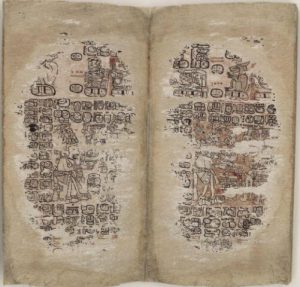
The Preclassic period was an era of gradual demographic growth, and of progressive elaboration of social and political institutions for all of the Mesoamerican societies. The rise of stratified societies was seen beginning in the early Preclassic, in regions such as the Pacific coast of Guatemala, as well as the development of Caciques during the middle Preclassic. On the contrary, the evidence available for the lower lands is less, and points towards a pattern of development relatively late in relation to neighboring regions.
The evidence available indicates that the lower areas were populated more slowly than many other Mesoamerican regions. However, beginning in the middle Preclassic a rapid growth in the social and political complexity is seen. The recent findings at the site of Nakbé suggest the rise of Caciques beginning in the middle Preclassic, which rely on the capacity for organization and the availability of the manpower necessary for the completion of construction projects of a large scale.
In review, the processes which led to the development of the complex societies in the lower Maya lands are not clear. Such a topic brings up significant problems, considering the environmental conditions of the region. In the same way, there are no definitive explanations for the development of some of the most important centers of this region, such as El Mirador and even Tikal, in locations apparently isolated and poor in natural resources, particularly water. However, it is evident the Preclassic inhabitants of the lower areas of Petén knew how to utilize the ecological conditions of the territory they inhabited to the maximum, which implies agricultural technologies sufficient for sustaining growing populations. The search for explanations for these processes presents a significant challenge for archaeological investigation.
Political organization
The primitive Mayas clustered in small hamlets, distant from each other. Later some ceremonial centers were erected. The life of these first inhabitants of the Maya area depended entirely on the natural elements and the cultivation and gathering of their crops.
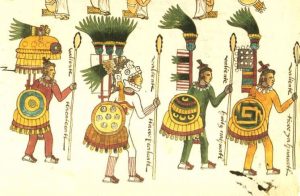
With a sedentary life and the continuing practice of primitive agriculture, there arose what at the beginning was the simple worship of nature and of the elements tied to sowing, such as the rain, the wind, the mountains, water, etc.
It must be imagined that the simple ceremonies were officiated and directed by the leader of the family. Later, with the incipient application of technology to agriculture, religious practice was organized in more complex form and the first professional priests arose.
The priests became the trustees of science and acquired a growing political power which made them into a dominant caste. The perfecting of the calendar, chronology and the hieroglyphic writings were owing to them..
In the 4th Century of our era, the Maya culture had been solidly established in the North and in the center of Petén. The Maya religion had become a highly developed and complex worship.
We have seen how the first stage of the ancient Maya civilization takes place during the cycle corresponding to hunting, fishing, and gathering. We have also seen the stage corresponding to the cultivation of the first plants or the initial period of the agricultural civilization. During this second stage a new political unity arose which was the village governed by a council of chiefs or heads of families.
The third phase of development of the Maya civilization corresponds to a social and economic order, in which the woman predominates and a matriarchy is established. The fourth stage of development is characterized by the consolidation of the essential forms of the Maya civilization and by the definitive passing of the maternal rights to paternal.
In the era of greatest flourishing of the Maya civilization, the hierarchy of power was made up of:
- Governing priests
- The Maya high priest (Ah-Kin-May)
- The priest (Halach Uinic)
- Chiefs and principal lords (Bacab)
- Royal steward
- Council of State, made up of the priests and nobility
- Warrior chiefs (Nacon)
Economic organization
The economy is very simple, as production depends on familial requirements, but little by little a division of labor develops, which will give rise to the differentiation of social classes.
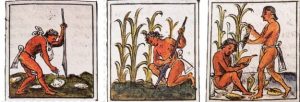
When agriculture begins and the Maya groups become sedentary, this activity becomes the basis of the economy, complemented with hunting, fishing, and gathering. The agricultural system of the Mayas was of a slash-and-burn nature, which consists of cutting down trees and bushes, burning them, and later planting using a sharp, called a cane planter, at the beginning of the rainy season.
The discovery of remains of hydraulic works indicates that the Maya constructed canals for irrigation, which allowed them a greater level of agricultural production. The land was used in a communal way.
Commerce experienced great development. Products like honey, resin, cotton, cacao, feathers, and obsidian were exported.
Social Organization
Society in this period is still of a tribal character, that is to say, groups of families related by kinship, which share a culture, a language, and a territory.
As agriculture becomes more complex, creating systems of irrigation and including the cultivation of commercial products, like cacao and cotton, the population grows and ceremonial centers begin to arise, and in the same way the hierarchical structuring of social classes is consolidated, which results from the division of labor.
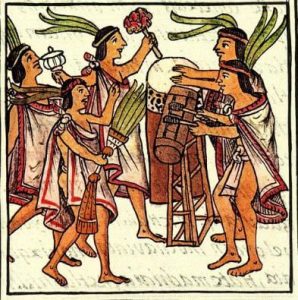
In the ceremonial centers and cities, which multiply during the Classic era and whose government was of a theocratic type, the ruling class lived, occupied with intellectual functions, like socioeconomic planning, the projection of public works, political organization, the creation of scientific knowledge (mathematics, astronomy, chronology, medicine) and the conservation, by means of a developed writing system, of the history of the governing families. The specialists (builders, artists, and artisans), as well as servants, also resided in the cities, while the peasants lived near their crops. Commerce was also realized on a large scale, making merchants a different social group.
In spite of all the changes which took place at the end of the Classic period and in the Postclassic, among which the predominance of pragmatic and militaristic interests stand out, the social hierarchical structure remains firm; the only change seems to have been the division of supreme power into political and religious power, which before were concentrated in only one person. According to the sources, the highest strata was made up of the nobles or gentlemen, called “almehenoob” by the Mayans of the Yucatan, the people of illustrious lineage, those destined by divine decree to rule over the rest, whether it be by political power, by religious power, or by the force of arms. Thus governors (headed by the Halach Uinic, “real man”), priests (a hierarchy at whose peak was the Ahau Can, “Serpent Lord”), warrior chiefs and perhaps merchants, who had certain political functions, belonged to this privileged class.
Under them were the people, the men without nobility or “Chembal Ah Uinicoob”, “inferior men,” who were dedicated to construction, the arts, craftsmanship, and working the ground. Slaves also existed (pentacoob), who were mostly delinquents, prisoners of war, orphans, and children of slaves; but they were not numerous nor did they play an important part in society.
Religion
The entire life of the Mayans was inspired by it, thus even the organization of the state was theocratic.
The Mayans paid worship to the forces of nature, their principal gods were:
- Hunab Ku (the creator), lord of the skies and god of the day.
- Itzamná (son of Hunab Ku)
- Chaac (god of rain, and of fertility in agriculture)
- Ah Puch (god of death)
- Yum Kaax (maize god)
This shows us that the Maya culture was polytheistic. All the Mayan creations are founded on a religious conception of the world, as this is conceived of divine origin and sped up by sacred energies which determine every happening. These energies are the gods, who embody the forces of nature, like the stars and the rain (Chaac); they are also energies of death, like the gods which produce sicknesses and death itself. But these deities also have animal aspects: the Sun at times shows itself like a macaw or a jaguar; the Rain, as a serpent; Death like a bat or an owl, etc. In the plastic arts they are represented as fantastic beings, mixes of various animals and human forms which carry some animal and vegetable attribute, like the eyes of a serpent, claws, fangs, and leaves growing from the forehead.
The universe is made up of three large horizontal planes: the sky, the earth, and the underworld. In the sky, divided in thirteen strata or levels, the stars reside, which are gods, like the moon (Ixchel) and Venus (Nohok Ek). The celestial space is represented by a deity called Itzamná, “the dragon,” which is represented as a feathered serpent with two heads or a dragon (a mix of serpent, bird, lizard, and deer). This god, which is the supreme god in the Maya religion symbolizes the fructifying energy of the cosmos, which instills life to the entire universe.
The earth is a flat sheet which floats on the water; but it is also conceived of as a great crocodile or lizard, on whose back vegetation grows. The Mayans of the Yucatan called it Chac Mumul Aín, “great muddy crocodile.”
Art
The Classical Mayans developed, according to their regions, diverse styles in architecture, painting, sculpture and other arts, in which they unfolded a high level of technical quality. The labor of the artists was intimately related to the social, cultural, and political characteristics of their environment. The ritual display was essential for reaffirming political power. The great architectural, sculptural, and pictorial works served as scenes of ritual and courtesan activity, which involved the use of luxurious artifacts, luxuriously elaborated, such as clothing, personal adornment, and others for ritual use. Among said objects, those of luxury also served as funerary utensils, whose degree of elaboration reflected the category of the individual in life. In good part, the art of the Classic period was derived from models which originated in the Preclassic. However, it was in the Classic period when the highest levels of artistic elaboration were reached, as much in the monumental arts as in more portable objects.
Architecture
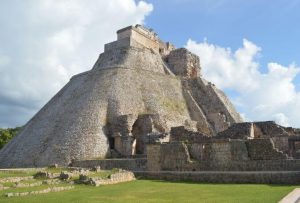
The planning of the Mayan ceremonial centers followed the topography and conditions of the terrain, that which determined the different forms and structures of the buildings. Mayan architecture shared in the general characteristics of the American cultures, but it had special modalities, even within its own style (the “false arch,” – Mayan vault-, cresting or combs, steles and altars, etc.). Various architectural styles were recorded, like the “style of Petén” in Uxmal; the “Usumacinta style” in Palenque; the “Puuc style” in Uxmal, etc. And in addition, there was another very valuable detail: that of painting integrated into architecture.
Sculpture
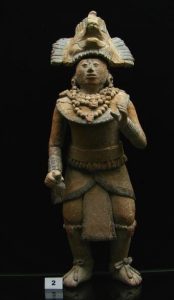
It includes a great variety of manifestations: altars, steles, tombstones, zoomorphic lintels, boards, thrones, doorposts, columns, bust figures, and markers for the ball game. Their principal characteristics are the use of relief, monumentality in the treatment of themes, the use of color in finished surfaces, dependence on the architectural field, the profusion of calligraphic and ornamental signs, the importance of curved lines and the multicolored and scenographic character of the composition. The commemorative steles are magnificent works, among which those of Tikal, Copán, Quiriguá, and Cobán. They are enormous slabs of stone stuck vertically in the ground, on which the Mayan sculptors worked images of the Jubilee of their kings in bas-relief. They were erected at the end of a concrete period of time, every five years, and every twenty years, and on them, through hieroglyphics, the most important events of the reign were narrated. The figurative lintels which flanked the doors of the palaces and temples at Yaxchilán, the altars of Piedras Negras and the zoomorphs of Quiriguá are excellent, although perhaps the peak of Mayan sculpture are the panels of the buildings at Palenque. The palace, and the temple of Inscriptions, of the Sun, the Cross, and the Foliated Cross, constitute one of the best examples of how man is capable of capturing in stone his religious universe.
Mural Art
Although the remains which have reached us are very scarce, the mural painting of the Classic Maya period reached a great technical perfection and a great artistic quality, achieving a difficult equilibrium between the naturalism of the designs and the gravity imposed by the conventionality of the themes. Although they use plain dyes devoid of perspective, the Mayan muralists knew how to create the illusion of space. First they traced the drawing in diluted red over a layer of stucco, later the background was painted, leaving the figures blank and later they went along filling in the different spaces with their respective colors. In order to suggest perspective and volume they turned to decorating the figures with fillets, juxtaposition of colors, and the distribution of motifs in diverse registers of horizontal bands. The most important murals which have been preserved are those at the site of Bonampak (Chiapas). The paintings occupy the totality of the walls of three rooms of a building (790 A.D.). They relate warlike events which include the ceremonies preliminary to the battle (room I), the battle (room II), and the final sacrifice (room III). Fragments of ancient paintings exist at Uaxactún, Palenque, Coba and Chichén Itzá.
Ceramics and stone
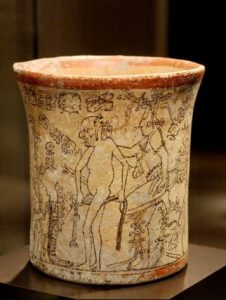
In the same way that the Maya muralists captured mythological and courtly scenes in their compositions, ceramicists reflected diverse aspects related to similar themes. Polychromatic ceramic — associated with the funerary world — was the most common. The technique was similar to that of the murals although they also played with the expressive possibilities which clay slips and polishing afforded them. They tend to be cylinders, dishes and platters with distinct dimensions where the painting covered nearly all of the surface. The profiles of the drawings were made in black over a cream or orange monochrome background. The other style, of which very few are preserved, called codex, records the technique utilized by the Mayan scribes on strips of stuccoed and painted plant-based paper. The anthropomorphic figures also reached a great popularity and perfection. The so-called Jaina Island figurines (Campeche) include a varied display of different physical types. To this distant island, illustrious characters of very diverse origins came to be buried, and the artisans of the necropolis prepared the furnishing which was to accompany them on their voyage to the world of the dead (Xibalbá).
The working of semiprecious stones, in jade and obsidian, implies a valuable contribution to Maya art. Human figures, eccentricities, and necklaces reached a degree of perfection which made them be included in the furnishings of the most princely tombs.
Textiles and Feather art
Although the extreme conditions of heat and humidity have impeded these manifestations arriving to us, the figurative scenes which appear on various supports permit us to come up with an idea of how they must have been. The kings and dignitaries appear dressed in loincloths, shirts, capes, tunics, and robes made of cotton, hide, and plant fibers. The feathered works also reached a great degree of development. The Maya artisans made use of a very rich tradition within the most appropriate natural media.
